Evaluating Australia's Renewable Energy Policy and Demand Management
VerifiedAdded on 2023/06/12
|8
|1487
|444
Report
AI Summary
This report examines Australia's renewable energy policy, contrasting it with Germany's experience. The analysis focuses on Australia's emphasis on balancing both demand and supply-side management to avoid the pitfalls of Germany's supply-centric approach, which led to high electricity prices. The report highlights the Greenhouse and Energy Minimum Standard Act and initiatives to improve energy efficiency in households and commercial buildings. It also recommends updating building codes and providing incentives for renewable energy use. Australia's approach aims to ensure a secure and reasonably priced energy supply by integrating demand management policies that reduce power bills and overall national costs. The document is available on Desklib, a platform offering a range of study tools and resources for students.
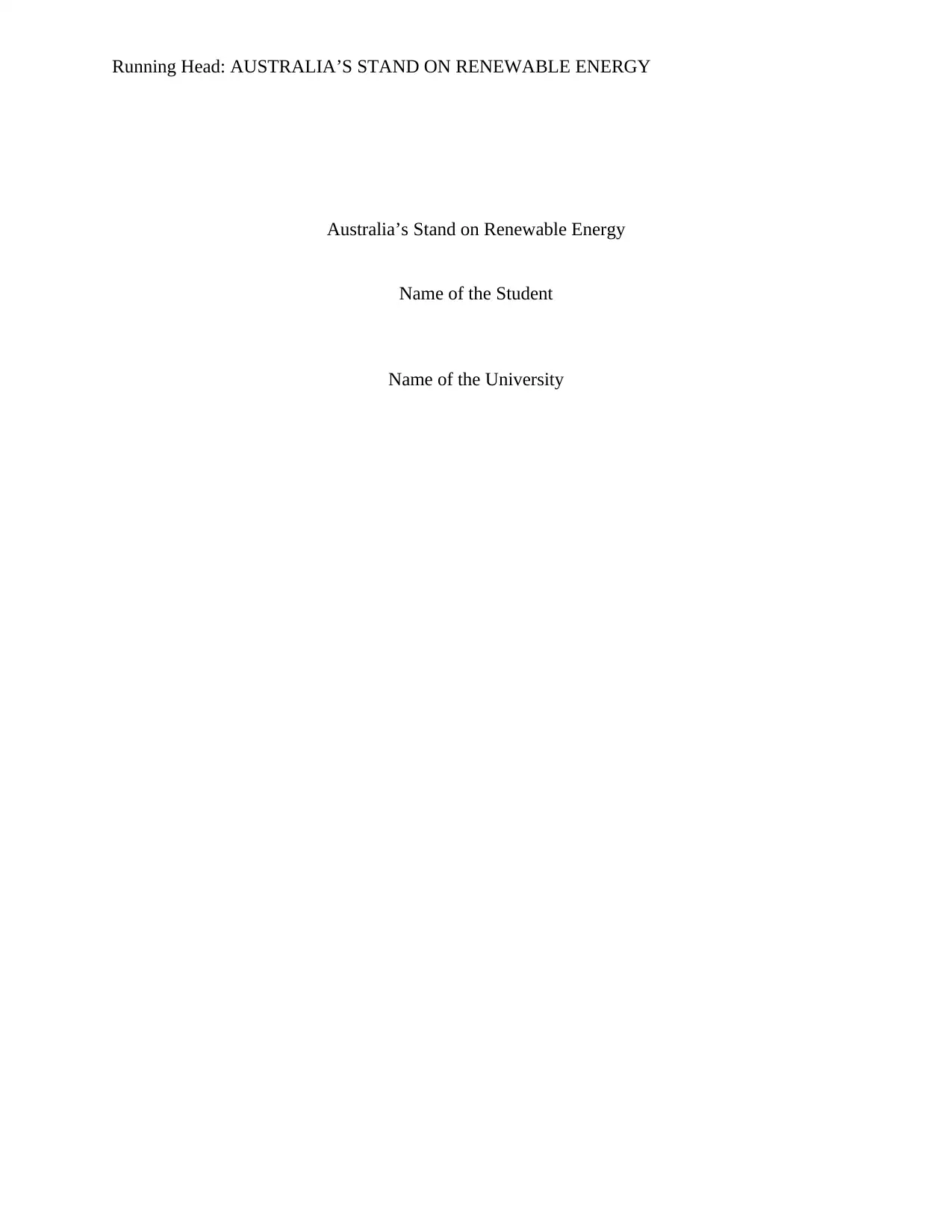
Running Head: AUSTRALIA’S STAND ON RENEWABLE ENERGY
Australia’s Stand on Renewable Energy
Name of the Student
Name of the University
Australia’s Stand on Renewable Energy
Name of the Student
Name of the University
Paraphrase This Document
Need a fresh take? Get an instant paraphrase of this document with our AI Paraphraser
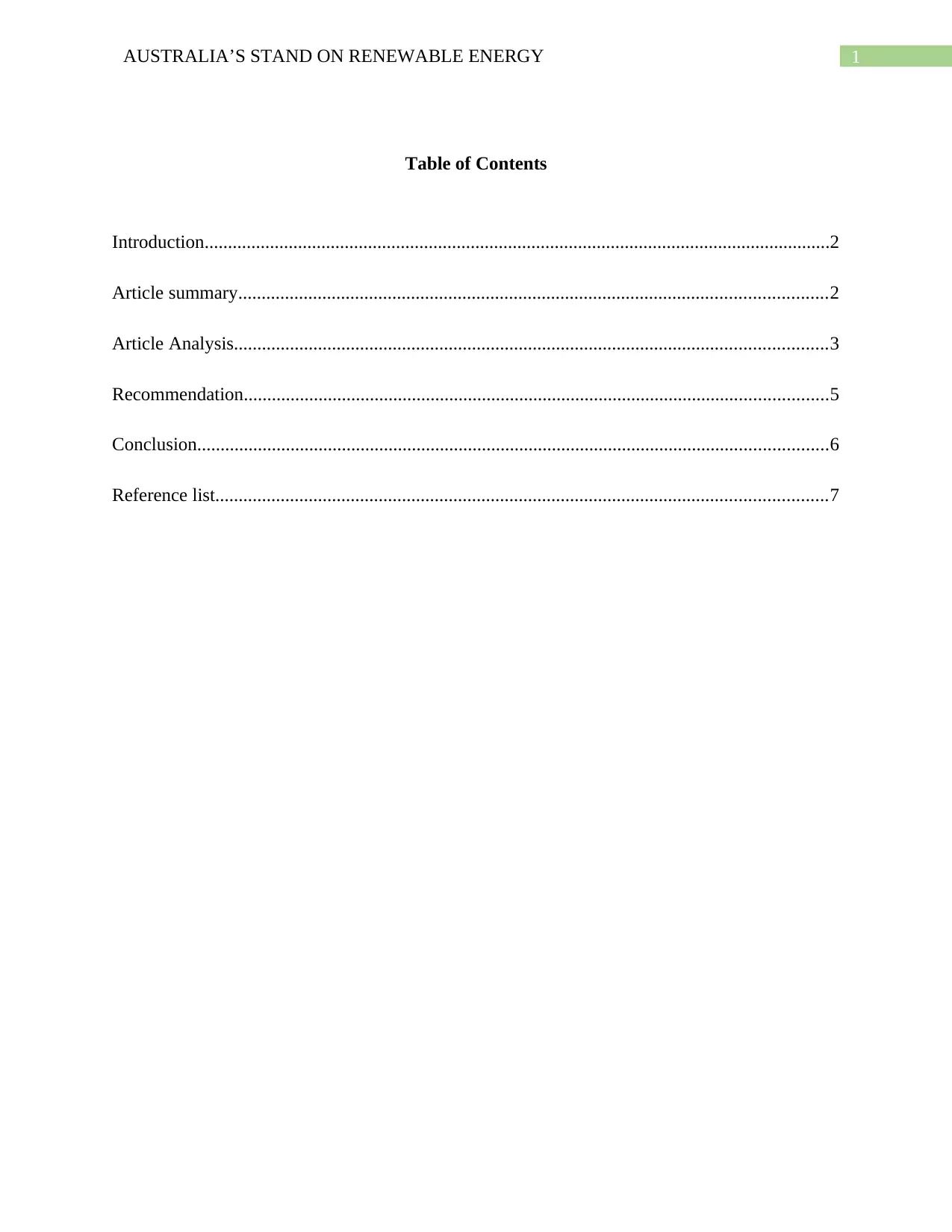
1AUSTRALIA’S STAND ON RENEWABLE ENERGY
Table of Contents
Introduction......................................................................................................................................2
Article summary..............................................................................................................................2
Article Analysis...............................................................................................................................3
Recommendation.............................................................................................................................5
Conclusion.......................................................................................................................................6
Reference list...................................................................................................................................7
Table of Contents
Introduction......................................................................................................................................2
Article summary..............................................................................................................................2
Article Analysis...............................................................................................................................3
Recommendation.............................................................................................................................5
Conclusion.......................................................................................................................................6
Reference list...................................................................................................................................7
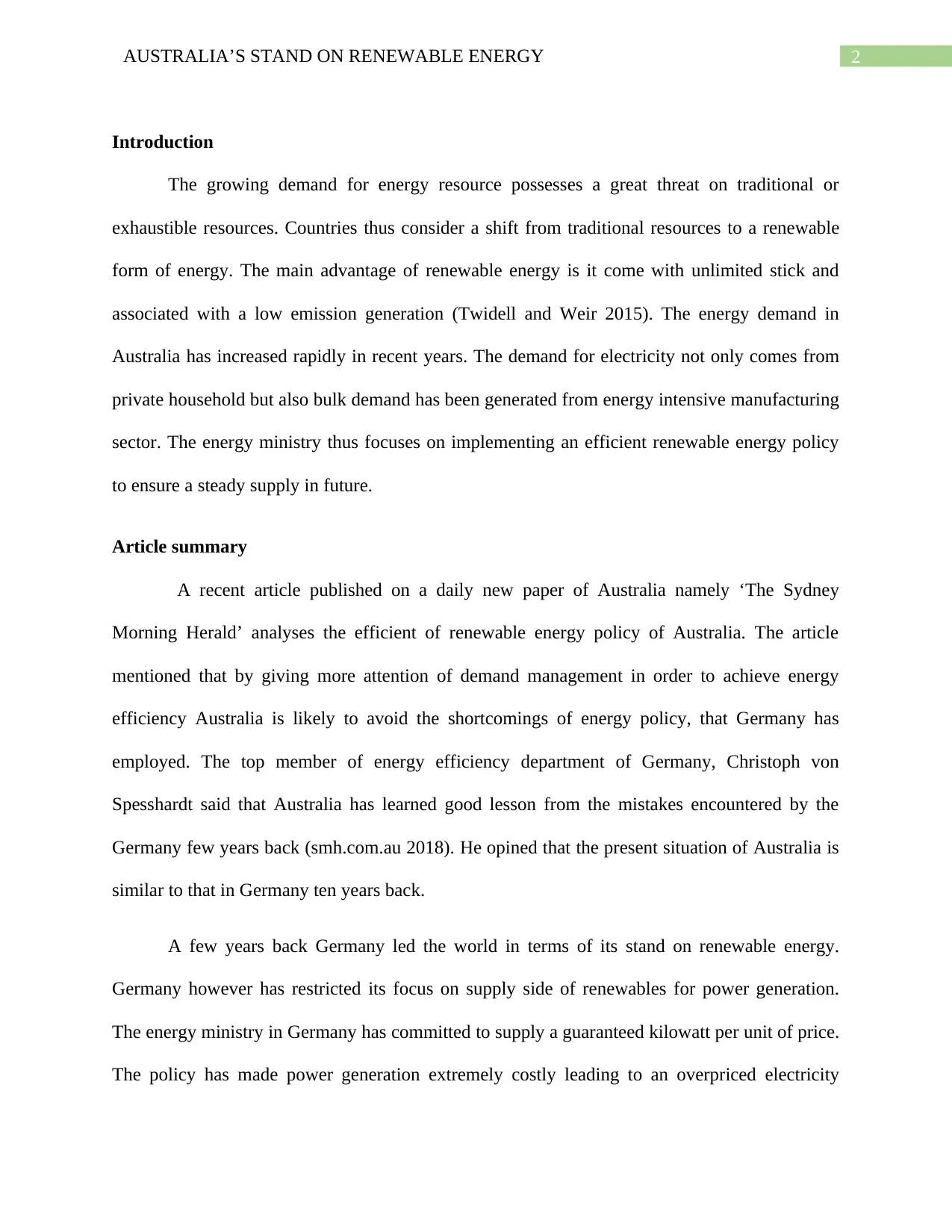
2AUSTRALIA’S STAND ON RENEWABLE ENERGY
Introduction
The growing demand for energy resource possesses a great threat on traditional or
exhaustible resources. Countries thus consider a shift from traditional resources to a renewable
form of energy. The main advantage of renewable energy is it come with unlimited stick and
associated with a low emission generation (Twidell and Weir 2015). The energy demand in
Australia has increased rapidly in recent years. The demand for electricity not only comes from
private household but also bulk demand has been generated from energy intensive manufacturing
sector. The energy ministry thus focuses on implementing an efficient renewable energy policy
to ensure a steady supply in future.
Article summary
A recent article published on a daily new paper of Australia namely ‘The Sydney
Morning Herald’ analyses the efficient of renewable energy policy of Australia. The article
mentioned that by giving more attention of demand management in order to achieve energy
efficiency Australia is likely to avoid the shortcomings of energy policy, that Germany has
employed. The top member of energy efficiency department of Germany, Christoph von
Spesshardt said that Australia has learned good lesson from the mistakes encountered by the
Germany few years back (smh.com.au 2018). He opined that the present situation of Australia is
similar to that in Germany ten years back.
A few years back Germany led the world in terms of its stand on renewable energy.
Germany however has restricted its focus on supply side of renewables for power generation.
The energy ministry in Germany has committed to supply a guaranteed kilowatt per unit of price.
The policy has made power generation extremely costly leading to an overpriced electricity
Introduction
The growing demand for energy resource possesses a great threat on traditional or
exhaustible resources. Countries thus consider a shift from traditional resources to a renewable
form of energy. The main advantage of renewable energy is it come with unlimited stick and
associated with a low emission generation (Twidell and Weir 2015). The energy demand in
Australia has increased rapidly in recent years. The demand for electricity not only comes from
private household but also bulk demand has been generated from energy intensive manufacturing
sector. The energy ministry thus focuses on implementing an efficient renewable energy policy
to ensure a steady supply in future.
Article summary
A recent article published on a daily new paper of Australia namely ‘The Sydney
Morning Herald’ analyses the efficient of renewable energy policy of Australia. The article
mentioned that by giving more attention of demand management in order to achieve energy
efficiency Australia is likely to avoid the shortcomings of energy policy, that Germany has
employed. The top member of energy efficiency department of Germany, Christoph von
Spesshardt said that Australia has learned good lesson from the mistakes encountered by the
Germany few years back (smh.com.au 2018). He opined that the present situation of Australia is
similar to that in Germany ten years back.
A few years back Germany led the world in terms of its stand on renewable energy.
Germany however has restricted its focus on supply side of renewables for power generation.
The energy ministry in Germany has committed to supply a guaranteed kilowatt per unit of price.
The policy has made power generation extremely costly leading to an overpriced electricity
⊘ This is a preview!⊘
Do you want full access?
Subscribe today to unlock all pages.

Trusted by 1+ million students worldwide
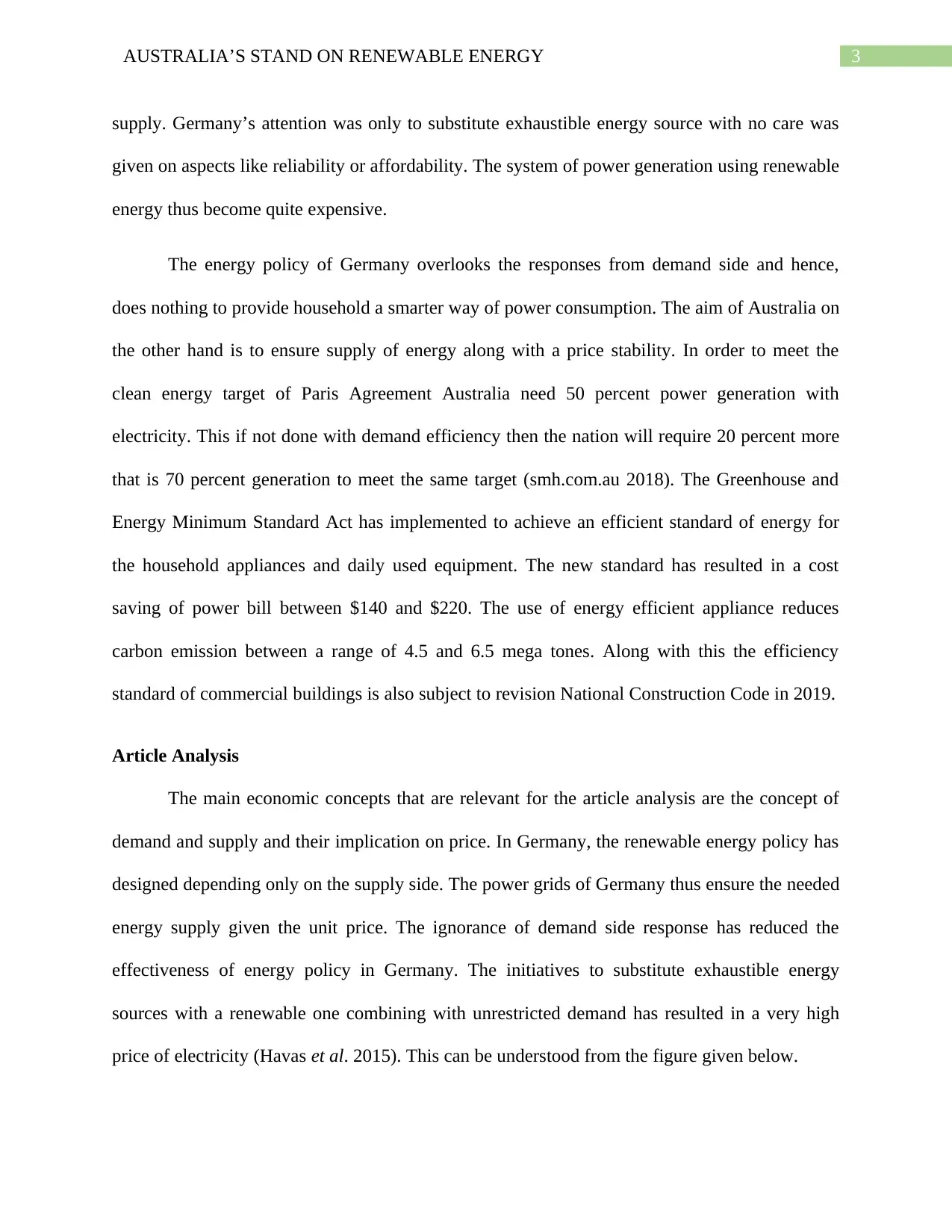
3AUSTRALIA’S STAND ON RENEWABLE ENERGY
supply. Germany’s attention was only to substitute exhaustible energy source with no care was
given on aspects like reliability or affordability. The system of power generation using renewable
energy thus become quite expensive.
The energy policy of Germany overlooks the responses from demand side and hence,
does nothing to provide household a smarter way of power consumption. The aim of Australia on
the other hand is to ensure supply of energy along with a price stability. In order to meet the
clean energy target of Paris Agreement Australia need 50 percent power generation with
electricity. This if not done with demand efficiency then the nation will require 20 percent more
that is 70 percent generation to meet the same target (smh.com.au 2018). The Greenhouse and
Energy Minimum Standard Act has implemented to achieve an efficient standard of energy for
the household appliances and daily used equipment. The new standard has resulted in a cost
saving of power bill between $140 and $220. The use of energy efficient appliance reduces
carbon emission between a range of 4.5 and 6.5 mega tones. Along with this the efficiency
standard of commercial buildings is also subject to revision National Construction Code in 2019.
Article Analysis
The main economic concepts that are relevant for the article analysis are the concept of
demand and supply and their implication on price. In Germany, the renewable energy policy has
designed depending only on the supply side. The power grids of Germany thus ensure the needed
energy supply given the unit price. The ignorance of demand side response has reduced the
effectiveness of energy policy in Germany. The initiatives to substitute exhaustible energy
sources with a renewable one combining with unrestricted demand has resulted in a very high
price of electricity (Havas et al. 2015). This can be understood from the figure given below.
supply. Germany’s attention was only to substitute exhaustible energy source with no care was
given on aspects like reliability or affordability. The system of power generation using renewable
energy thus become quite expensive.
The energy policy of Germany overlooks the responses from demand side and hence,
does nothing to provide household a smarter way of power consumption. The aim of Australia on
the other hand is to ensure supply of energy along with a price stability. In order to meet the
clean energy target of Paris Agreement Australia need 50 percent power generation with
electricity. This if not done with demand efficiency then the nation will require 20 percent more
that is 70 percent generation to meet the same target (smh.com.au 2018). The Greenhouse and
Energy Minimum Standard Act has implemented to achieve an efficient standard of energy for
the household appliances and daily used equipment. The new standard has resulted in a cost
saving of power bill between $140 and $220. The use of energy efficient appliance reduces
carbon emission between a range of 4.5 and 6.5 mega tones. Along with this the efficiency
standard of commercial buildings is also subject to revision National Construction Code in 2019.
Article Analysis
The main economic concepts that are relevant for the article analysis are the concept of
demand and supply and their implication on price. In Germany, the renewable energy policy has
designed depending only on the supply side. The power grids of Germany thus ensure the needed
energy supply given the unit price. The ignorance of demand side response has reduced the
effectiveness of energy policy in Germany. The initiatives to substitute exhaustible energy
sources with a renewable one combining with unrestricted demand has resulted in a very high
price of electricity (Havas et al. 2015). This can be understood from the figure given below.
Paraphrase This Document
Need a fresh take? Get an instant paraphrase of this document with our AI Paraphraser
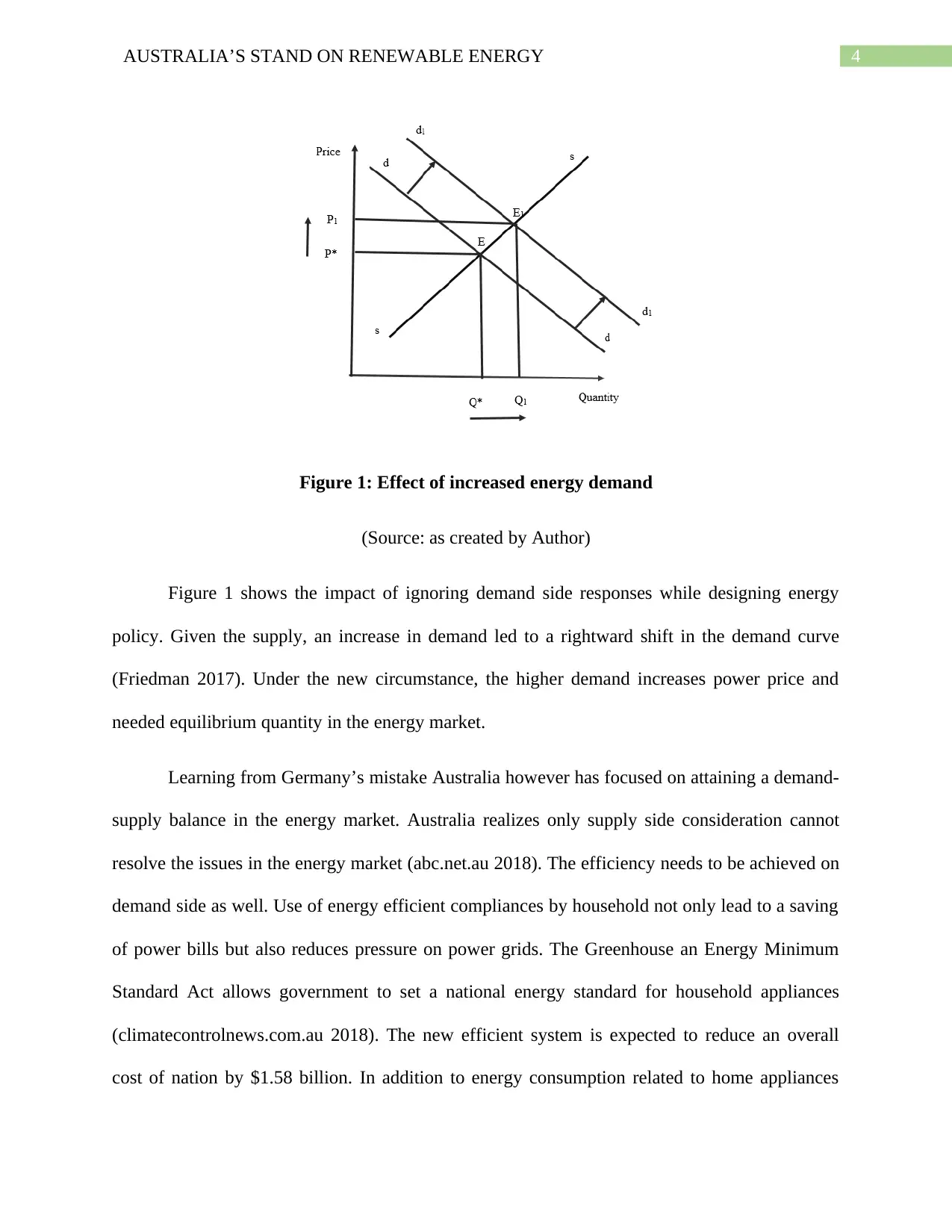
4AUSTRALIA’S STAND ON RENEWABLE ENERGY
Figure 1: Effect of increased energy demand
(Source: as created by Author)
Figure 1 shows the impact of ignoring demand side responses while designing energy
policy. Given the supply, an increase in demand led to a rightward shift in the demand curve
(Friedman 2017). Under the new circumstance, the higher demand increases power price and
needed equilibrium quantity in the energy market.
Learning from Germany’s mistake Australia however has focused on attaining a demand-
supply balance in the energy market. Australia realizes only supply side consideration cannot
resolve the issues in the energy market (abc.net.au 2018). The efficiency needs to be achieved on
demand side as well. Use of energy efficient compliances by household not only lead to a saving
of power bills but also reduces pressure on power grids. The Greenhouse an Energy Minimum
Standard Act allows government to set a national energy standard for household appliances
(climatecontrolnews.com.au 2018). The new efficient system is expected to reduce an overall
cost of nation by $1.58 billion. In addition to energy consumption related to home appliances
Figure 1: Effect of increased energy demand
(Source: as created by Author)
Figure 1 shows the impact of ignoring demand side responses while designing energy
policy. Given the supply, an increase in demand led to a rightward shift in the demand curve
(Friedman 2017). Under the new circumstance, the higher demand increases power price and
needed equilibrium quantity in the energy market.
Learning from Germany’s mistake Australia however has focused on attaining a demand-
supply balance in the energy market. Australia realizes only supply side consideration cannot
resolve the issues in the energy market (abc.net.au 2018). The efficiency needs to be achieved on
demand side as well. Use of energy efficient compliances by household not only lead to a saving
of power bills but also reduces pressure on power grids. The Greenhouse an Energy Minimum
Standard Act allows government to set a national energy standard for household appliances
(climatecontrolnews.com.au 2018). The new efficient system is expected to reduce an overall
cost of nation by $1.58 billion. In addition to energy consumption related to home appliances
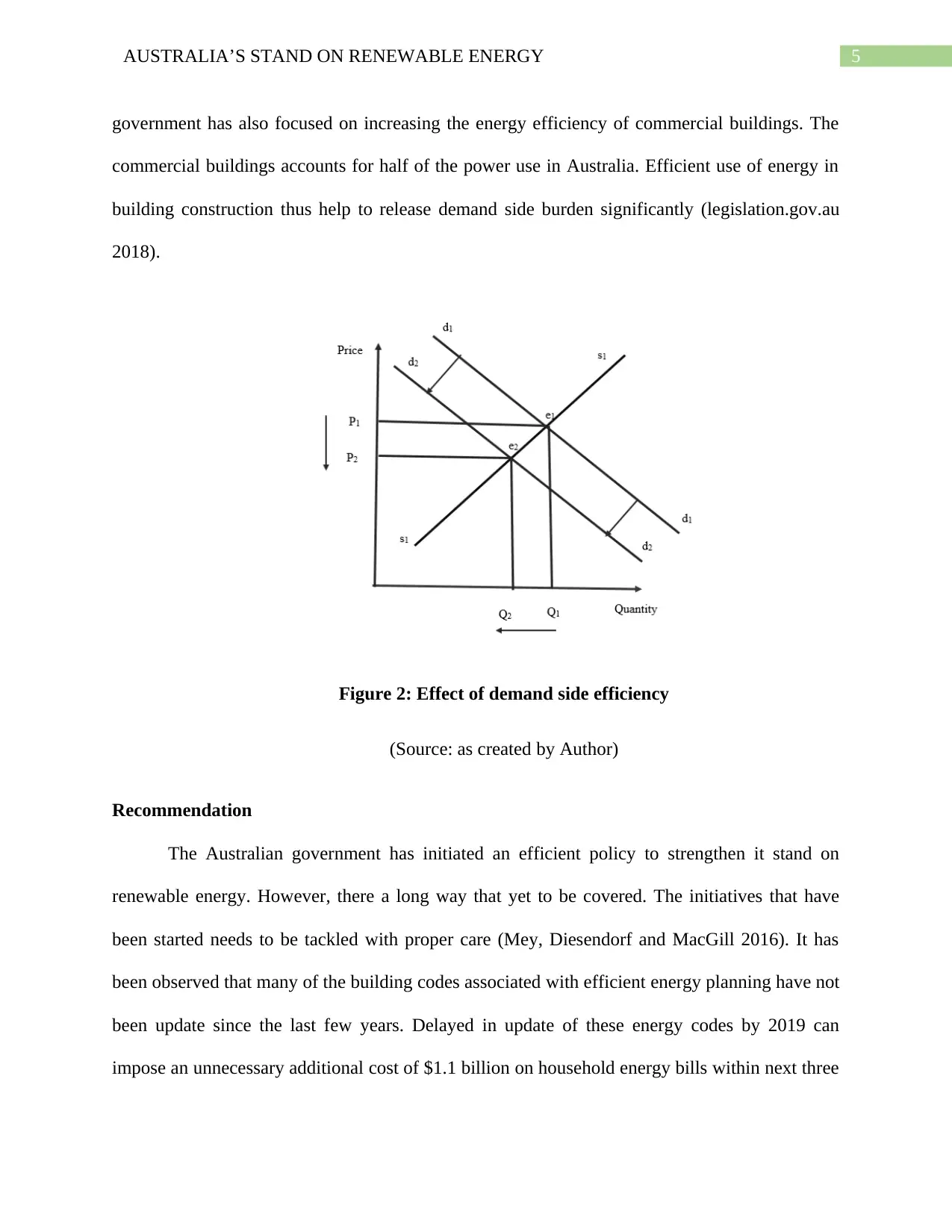
5AUSTRALIA’S STAND ON RENEWABLE ENERGY
government has also focused on increasing the energy efficiency of commercial buildings. The
commercial buildings accounts for half of the power use in Australia. Efficient use of energy in
building construction thus help to release demand side burden significantly (legislation.gov.au
2018).
Figure 2: Effect of demand side efficiency
(Source: as created by Author)
Recommendation
The Australian government has initiated an efficient policy to strengthen it stand on
renewable energy. However, there a long way that yet to be covered. The initiatives that have
been started needs to be tackled with proper care (Mey, Diesendorf and MacGill 2016). It has
been observed that many of the building codes associated with efficient energy planning have not
been update since the last few years. Delayed in update of these energy codes by 2019 can
impose an unnecessary additional cost of $1.1 billion on household energy bills within next three
government has also focused on increasing the energy efficiency of commercial buildings. The
commercial buildings accounts for half of the power use in Australia. Efficient use of energy in
building construction thus help to release demand side burden significantly (legislation.gov.au
2018).
Figure 2: Effect of demand side efficiency
(Source: as created by Author)
Recommendation
The Australian government has initiated an efficient policy to strengthen it stand on
renewable energy. However, there a long way that yet to be covered. The initiatives that have
been started needs to be tackled with proper care (Mey, Diesendorf and MacGill 2016). It has
been observed that many of the building codes associated with efficient energy planning have not
been update since the last few years. Delayed in update of these energy codes by 2019 can
impose an unnecessary additional cost of $1.1 billion on household energy bills within next three
⊘ This is a preview!⊘
Do you want full access?
Subscribe today to unlock all pages.

Trusted by 1+ million students worldwide
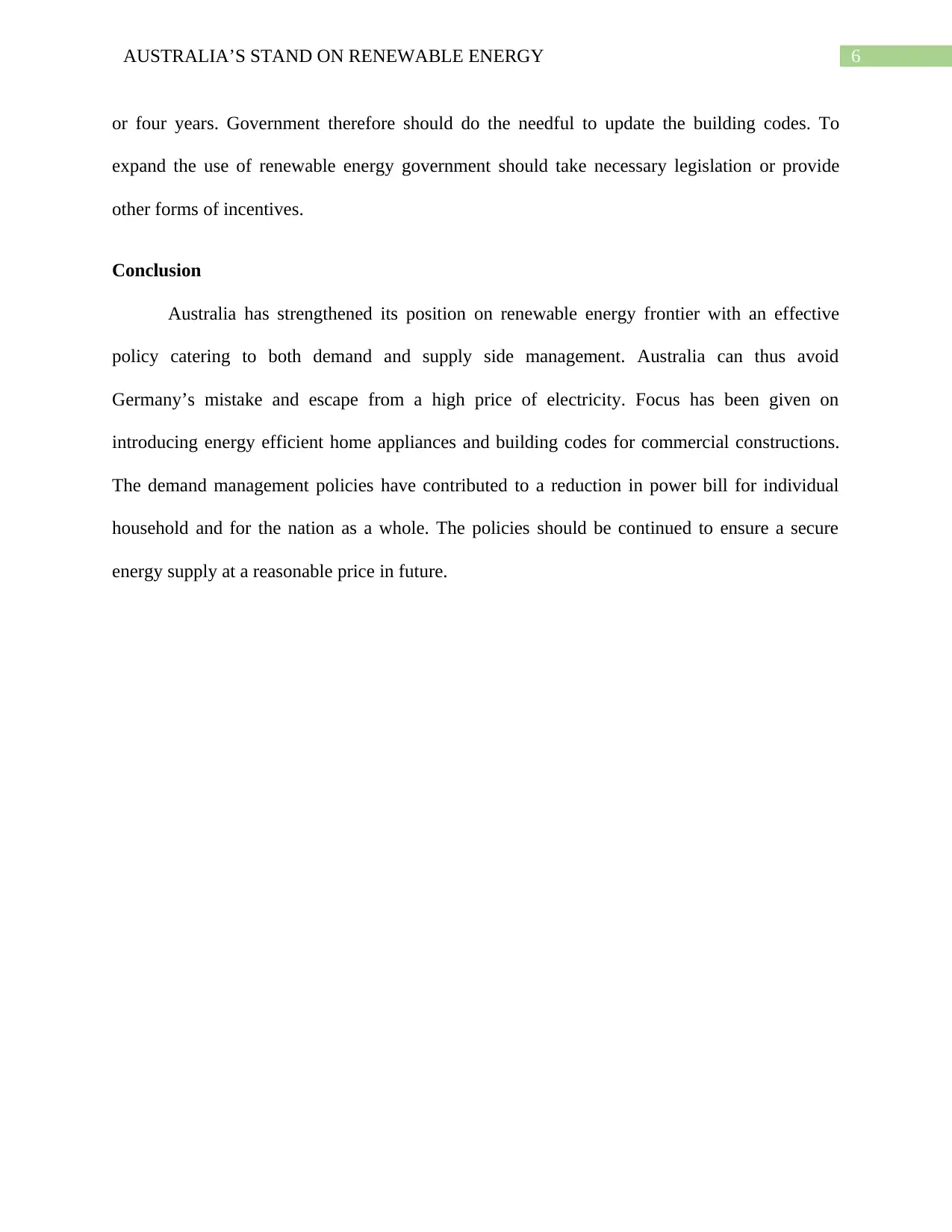
6AUSTRALIA’S STAND ON RENEWABLE ENERGY
or four years. Government therefore should do the needful to update the building codes. To
expand the use of renewable energy government should take necessary legislation or provide
other forms of incentives.
Conclusion
Australia has strengthened its position on renewable energy frontier with an effective
policy catering to both demand and supply side management. Australia can thus avoid
Germany’s mistake and escape from a high price of electricity. Focus has been given on
introducing energy efficient home appliances and building codes for commercial constructions.
The demand management policies have contributed to a reduction in power bill for individual
household and for the nation as a whole. The policies should be continued to ensure a secure
energy supply at a reasonable price in future.
or four years. Government therefore should do the needful to update the building codes. To
expand the use of renewable energy government should take necessary legislation or provide
other forms of incentives.
Conclusion
Australia has strengthened its position on renewable energy frontier with an effective
policy catering to both demand and supply side management. Australia can thus avoid
Germany’s mistake and escape from a high price of electricity. Focus has been given on
introducing energy efficient home appliances and building codes for commercial constructions.
The demand management policies have contributed to a reduction in power bill for individual
household and for the nation as a whole. The policies should be continued to ensure a secure
energy supply at a reasonable price in future.
Paraphrase This Document
Need a fresh take? Get an instant paraphrase of this document with our AI Paraphraser
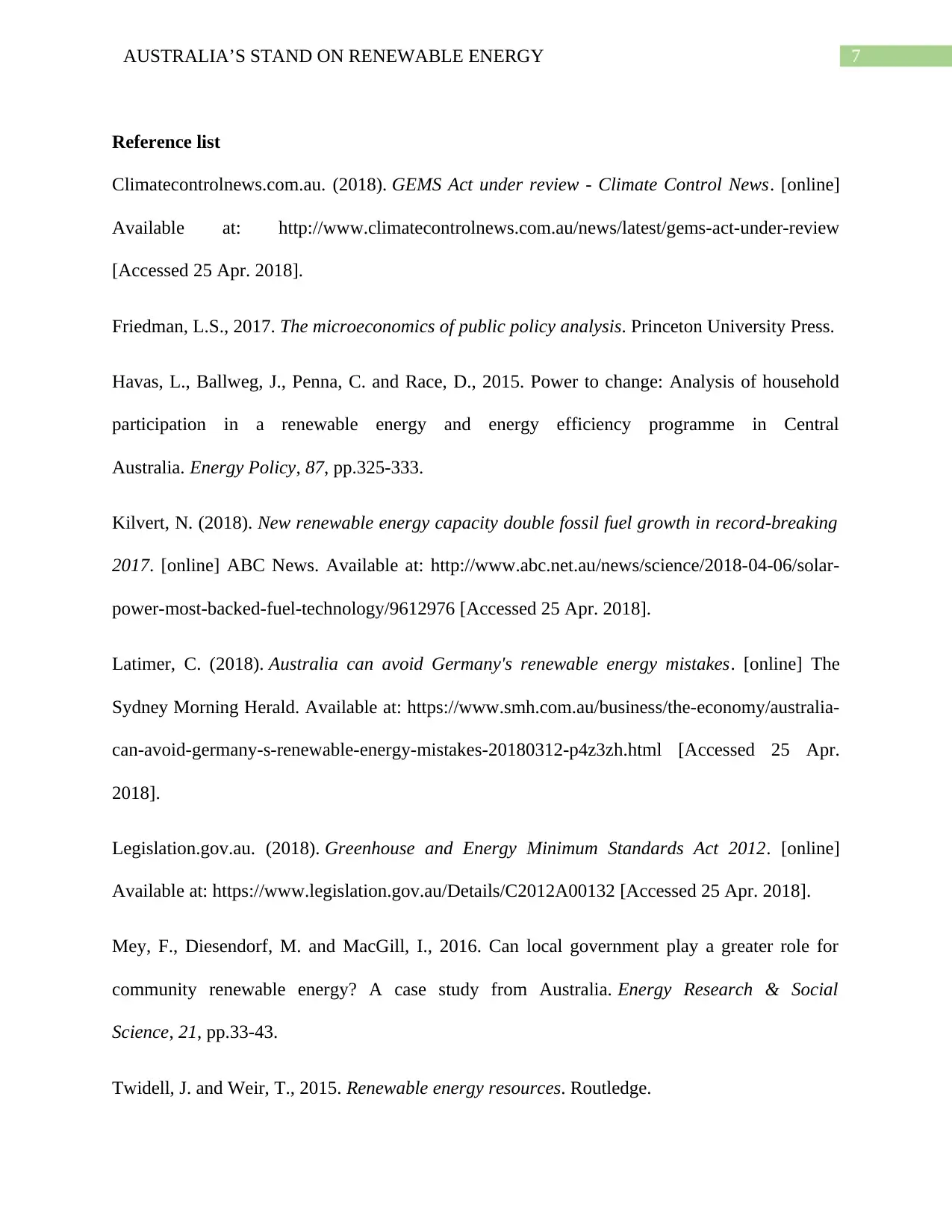
7AUSTRALIA’S STAND ON RENEWABLE ENERGY
Reference list
Climatecontrolnews.com.au. (2018). GEMS Act under review - Climate Control News. [online]
Available at: http://www.climatecontrolnews.com.au/news/latest/gems-act-under-review
[Accessed 25 Apr. 2018].
Friedman, L.S., 2017. The microeconomics of public policy analysis. Princeton University Press.
Havas, L., Ballweg, J., Penna, C. and Race, D., 2015. Power to change: Analysis of household
participation in a renewable energy and energy efficiency programme in Central
Australia. Energy Policy, 87, pp.325-333.
Kilvert, N. (2018). New renewable energy capacity double fossil fuel growth in record-breaking
2017. [online] ABC News. Available at: http://www.abc.net.au/news/science/2018-04-06/solar-
power-most-backed-fuel-technology/9612976 [Accessed 25 Apr. 2018].
Latimer, C. (2018). Australia can avoid Germany's renewable energy mistakes. [online] The
Sydney Morning Herald. Available at: https://www.smh.com.au/business/the-economy/australia-
can-avoid-germany-s-renewable-energy-mistakes-20180312-p4z3zh.html [Accessed 25 Apr.
2018].
Legislation.gov.au. (2018). Greenhouse and Energy Minimum Standards Act 2012. [online]
Available at: https://www.legislation.gov.au/Details/C2012A00132 [Accessed 25 Apr. 2018].
Mey, F., Diesendorf, M. and MacGill, I., 2016. Can local government play a greater role for
community renewable energy? A case study from Australia. Energy Research & Social
Science, 21, pp.33-43.
Twidell, J. and Weir, T., 2015. Renewable energy resources. Routledge.
Reference list
Climatecontrolnews.com.au. (2018). GEMS Act under review - Climate Control News. [online]
Available at: http://www.climatecontrolnews.com.au/news/latest/gems-act-under-review
[Accessed 25 Apr. 2018].
Friedman, L.S., 2017. The microeconomics of public policy analysis. Princeton University Press.
Havas, L., Ballweg, J., Penna, C. and Race, D., 2015. Power to change: Analysis of household
participation in a renewable energy and energy efficiency programme in Central
Australia. Energy Policy, 87, pp.325-333.
Kilvert, N. (2018). New renewable energy capacity double fossil fuel growth in record-breaking
2017. [online] ABC News. Available at: http://www.abc.net.au/news/science/2018-04-06/solar-
power-most-backed-fuel-technology/9612976 [Accessed 25 Apr. 2018].
Latimer, C. (2018). Australia can avoid Germany's renewable energy mistakes. [online] The
Sydney Morning Herald. Available at: https://www.smh.com.au/business/the-economy/australia-
can-avoid-germany-s-renewable-energy-mistakes-20180312-p4z3zh.html [Accessed 25 Apr.
2018].
Legislation.gov.au. (2018). Greenhouse and Energy Minimum Standards Act 2012. [online]
Available at: https://www.legislation.gov.au/Details/C2012A00132 [Accessed 25 Apr. 2018].
Mey, F., Diesendorf, M. and MacGill, I., 2016. Can local government play a greater role for
community renewable energy? A case study from Australia. Energy Research & Social
Science, 21, pp.33-43.
Twidell, J. and Weir, T., 2015. Renewable energy resources. Routledge.
1 out of 8
Related Documents
Your All-in-One AI-Powered Toolkit for Academic Success.
+13062052269
info@desklib.com
Available 24*7 on WhatsApp / Email
![[object Object]](/_next/static/media/star-bottom.7253800d.svg)
Unlock your academic potential
Copyright © 2020–2025 A2Z Services. All Rights Reserved. Developed and managed by ZUCOL.




